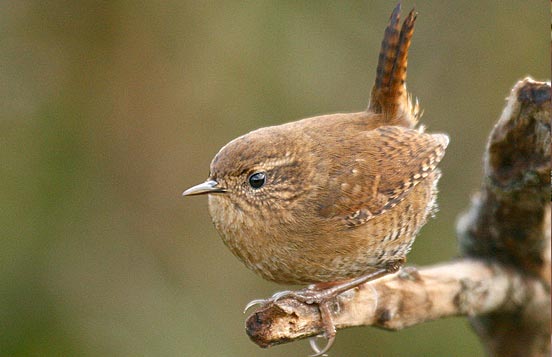The Winter Wren’s Wraparound Range Map
By Irby Lovette April 15, 2009
Taxonomic note: In 2010, the AOU split the Winter Wren into three species: the Pacific Wren, Winter Wren, and Eurasian Wren.
The Winter Wren is well-known for being hard to see but easy to hear. New studies of the vocal behaviors of these diminutive songsters have revealed a dramatic evolutionary collision in a remote region of boreal Canada.
Unusually for a small songbird, the Winter Wren has a truly cosmopolitan distribution, with more than 40 subspecies distributed in a broad ring around the Northern Hemisphere. In North America, these tiny birds breed most commonly in moist, conifer-dominated forests, where the exuberant songs of male Winter Wrens seem to celebrate the onset of spring. Closely related forms breed across Asia and Europe; Shakespeare and his descendants in the British Isles have known these birds simply as “the wren,” because this is the only type of wren that has ever colonized beyond the Americas.
The Northern Hemisphere is a big place, especially as the wren flies. Many regional populations of these wrens have evolved distinctive differences, especially in their songs. Starting in the 1980s, a series of studies by Don Kroodsma and colleagues showed that these regional song differences are particularly pronounced in North America: wrens in eastern North America sing much like wrens in England, whereas wrens in western North America sing more like those in Siberia.
Subsequent investigations using genetic techniques have told a similar story: the Winter Wren populations that wrap around the globe are like links in a long chain, with the ends of the chain resting near one another somewhere in western Canada, where the most dissimilar wren populations exist close to one another.
Until recently, however, no locations had been discovered where these highly dissimilar Winter Wren types actually coexist. Canadian biologists David Toews and Darren Irwin set out, tape-recorders and mist-nets in hand, to search for places where these birds with different songs breed in close proximity. After much sleuthing, they found what they were looking for along the Murray River in eastern British Columbia.
Reporting on their study in the journal Molecular Ecology, these researchers found that in this remote region, a male Winter Wren with an eastern song may have a neighbor on an adjacent territory that sings a western song. Male wrens with each song type responded aggressively to artificial playbacks of the other song type, showing that despite their evolutionary differences they still recognize one another as potential competitors.
But what do the female wrens think about their menu of potential mates? When Toews and Irwin compared all of the birds they sampled from the collision zone, they found that birds singing the eastern song always had eastern-type DNA, and that western-singing birds had western-type DNA. This simple pattern reveals something surprisingly important: very little interbreeding is going on between these forms, even in this area where they both occur.
It seems likely that the female wrens in this area are listening closely to the males, then choosing as mates those that sing the appropriate song type. If this is a general trend wherever these wren forms come into contact, then these similar-looking but different-sounding wrens may be well on their way to becoming separate species, with their effusive songs signaling evolutionary divisions far more profound than the boundary of each male’s territory.

All About Birds
is a free resource
Available for everyone,
funded by donors like you
American Kestrel by Blair Dudeck / Macaulay Library



